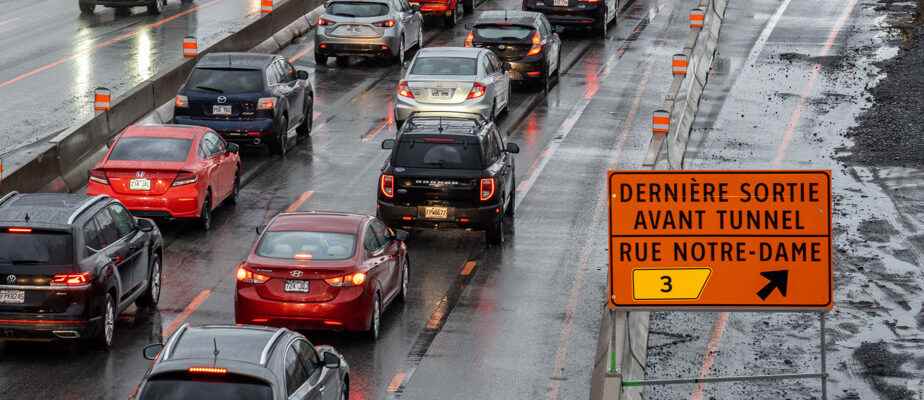Three months after the partial closure of the Louis-Hippolyte-La Fontaine bridge-tunnel, the Plante administration is concerned about the “increasing transit traffic” generated by the megaconstruction site in certain neighborhoods. In addition to traffic calming measures, Montreal is calling in particular to quickly multiply photo radars, an idea that the Minister of Transport, Geneviève Guilbault, promises to tackle soon.
“In the Centre-Sud, in Sainte-Marie, but also in Mercier–Hochelaga-Maisonneuve, we unfortunately see that, despite our efforts, there is growing transit traffic in the neighbourhoods. It is linked to the Louis-Hippolyte-La Fontaine tunnel, but it is also an illustration of the fact that we are reaching a level of saturation of our network, which makes cohabitation much more difficult, “says the manager of mobility at the City of Montreal, Sophie Mauzerolle.
The Plante administration claims to have already implemented “several bans on right turns and speed bumps” in the most critical sectors. “That said, it is very difficult to predict changes in motorist behavior. In any case, the huge upsurge in collisions clearly shows us that there are too many cars on the roads, that people are driving too fast. And that we need to speed up public transit projects,” continues Ms.me Mauzerolle.
Three sections of street will become one-way by September in the Center-South, including the one where the fatal accident that took the life of little Mariia occurred in mid-December.
“This is just the beginning for the neighborhood,” said Mayor Valérie Plante last week, saying she wanted to “secure the entire Centre-Sud”.

PHOTO PATRICK SANFAÇON, LA PRESSE ARCHIVES
On December 13, an accident followed by a hit and run resulted in the death of Mariia Legenkovska, 7, at the corner of Parthenais and De Rouen, in Montreal. To enhance safety in the area, this stretch of road is now a one-way street.
But Montreal insists: much more will have to be done. One of the preferred options: increase the presence of photo radars, especially near school zones, where the speed of motorists “too often” exceeds the permitted limit. “We see the performance of these tools: it works, it leads to a change in behavior. We want more, close to schools, on the arterial network, ”says Sophie Mauzerolle, calling on Quebec to increase their number in the coming months.
The Press reported on Monday that the City of Montreal has submitted a project to the Ministry of Transport (MTQ) to install photo radars in densely populated neighborhoods. Currently, a municipality must obtain Ministry approval to use photo radar outside of a school zone.
Guilbault wants more photo radars
For the moment, in Quebec, there are 54 photo radars, of which 30 are “fixed” and 24 are “mobile”, thus being able to be moved on the territory if necessary. It is in itself much less than elsewhere. By way of comparison, there will soon be 75 in Toronto, where a pilot project is also deploying 120 mobile photo radars rotating in different school zones. Vancouver alone has 35, while Ottawa has already installed 17, which have caught more than 106,000 offending drivers in 2022.
This week, Minister Geneviève Guilbault promised to table a “reinforced action plan” in terms of road safety which will make an “important place” for photo radars, in response to parents who are mobilizing to demand better safety in travel. active around schools.
In an interview, the minister confirms “assessing the possibility of adding more photo radars”, without however advancing on a precise figure.
“It is a measure that is effective. We look at different technologies around the world. Here, we are used to our mobile radars, but in France, in certain municipalities, they are testing new kinds of radars that they have just installed. We really want to have what could be the most effective”, she said nevertheless, also mentioning the possibility of reviewing in passing the governance behind these devices, which for the moment “mobilize a lot of police and judicial resources”.
“It must come with several other measures. There is also a lot of awareness and prevention to be done,” continues Ms.me Guilbault, who is particularly concerned that in 30% of collisions recorded by the Sûreté du Québec (SQ) last year, people were not wearing a belt. “There may be reminders to do on things that we take for granted,” says the elected official.
She says it is essential to “find a balance between safety around schools” and her “desire for young people to be active, to be able to walk or cycle to school in a safe way”. “I spoke about it with my colleague [la ministre responsable du Sport et du Loisir] Isabel Charest. We are looking at several options, ”says M.me Guilbault.
A meeting is scheduled soon between Valérie Plante and Geneviève Guilbault, in Montreal. The issue of road safety should be at the top of the priorities.
